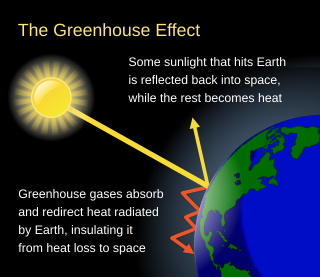
The greenhouse effect occurs when greenhouse gases in a planet's atmosphere cause some of the heat radiated from the planet's surface to build up at the planet's surface. This process happens because stars emit shortwave radiation that passes through greenhouse gases, but planets emit longwave radiation that is partly absorbed by greenhouse gases. That difference reduces the rate at which a planet can cool off in response to being warmed by its host star. Adding to greenhouse gases further reduces the rate a planet emits radiation to space, raising its average surface temperature.

Infrared is electromagnetic radiation (EMR) in the spectral band between microwaves and visible light. It is invisible to the human eye. IR is generally understood to encompass wavelengths from around 750 nm to 100 μm.

Numerical climate models use quantitative methods to simulate the interactions of the important drivers of climate, including atmosphere, oceans, land surface and ice. They are used for a variety of purposes from study of the dynamics of the climate system to projections of future climate. Climate models may also be qualitative models and also narratives, largely descriptive, of possible futures.

Shortwave radiation (SW) is thermal radiation in the optical spectrum, including visible (VIS), near-ultraviolet (UV), and near-infrared (NIR) spectra.
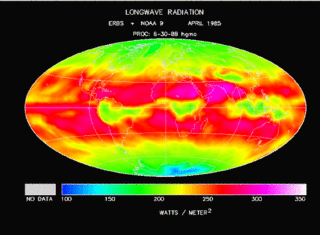
In the study of heat transfer, radiative cooling is the process by which a body loses heat by thermal radiation. As Planck's law describes, every physical body spontaneously and continuously emits electromagnetic radiation.

Heat transfer is a discipline of thermal engineering that concerns the generation, use, conversion, and exchange of thermal energy (heat) between physical systems. Heat transfer is classified into various mechanisms, such as thermal conduction, thermal convection, thermal radiation, and transfer of energy by phase changes. Engineers also consider the transfer of mass of differing chemical species, either cold or hot, to achieve heat transfer. While these mechanisms have distinct characteristics, they often occur simultaneously in the same system.

Thermal radiation is electromagnetic radiation generated by the thermal motion of particles in matter. Thermal radiation is generated when heat from the movement of charges in the material is converted to electromagnetic radiation. All matter with a temperature greater than absolute zero emits thermal radiation. At room temperature, most of the emission is in the infrared (IR) spectrum. Particle motion results in charge-acceleration or dipole oscillation which produces electromagnetic radiation.

The emissivity of the surface of a material is its effectiveness in emitting energy as thermal radiation. Thermal radiation is electromagnetic radiation that most commonly includes both visible radiation (light) and infrared radiation, which is not visible to human eyes. A portion of the thermal radiation from very hot objects is easily visible to the eye.
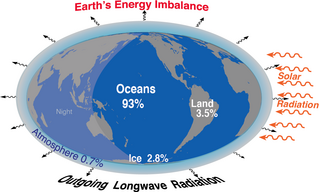
Earth's energy budget accounts for the balance between the energy that Earth receives from the Sun and the energy the Earth loses back into outer space. Smaller energy sources, such as Earth's internal heat, are taken into consideration, but make a tiny contribution compared to solar energy. The energy budget also accounts for how energy moves through the climate system. Because the Sun heats the equatorial tropics more than the polar regions, received solar irradiance is unevenly distributed. As the energy seeks equilibrium across the planet, it drives interactions in Earth's climate system, i.e., Earth's water, ice, atmosphere, rocky crust, and all living things. The result is Earth's climate.
The effective temperature of a body such as a star or planet is the temperature of a black body that would emit the same total amount of electromagnetic radiation. Effective temperature is often used as an estimate of a body's surface temperature when the body's emissivity curve is not known.

In climate science, longwave radiation (LWR) is electromagnetic thermal radiation emitted by Earth's surface, atmosphere, and clouds. It may also be referred to as terrestrial radiation. This radiation is in the infrared portion of the spectrum, but is distinct from the shortwave (SW) near-infrared radiation found in sunlight.
An atmospheric radiative transfer model, code, or simulator calculates radiative transfer of electromagnetic radiation through a planetary atmosphere.
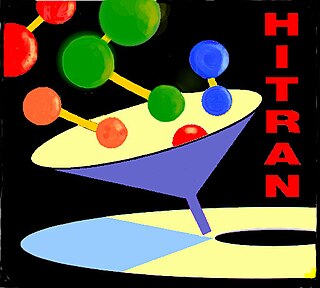
HITRAN molecular spectroscopic database is a compilation of spectroscopic parameters used to simulate and analyze the transmission and emission of light in gaseous media, with an emphasis on planetary atmospheres. The knowledge of spectroscopic parameters for transitions between energy levels in molecules is essential for interpreting and modeling the interaction of radiation (light) within different media.
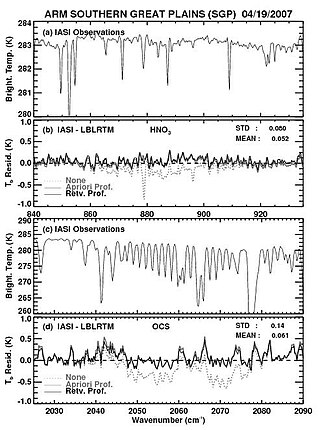
Within atmospheric science, LBLRTM - The Line-By-Line Radiative Transfer Model is an accurate, efficient and highly flexible model for calculating spectral transmittance and radiance.

The temperatures of a planet's surface and atmosphere are governed by a delicate balancing of their energy flows. The idealized greenhouse model is based on the fact that certain gases in the Earth's atmosphere, including carbon dioxide and water vapour, are transparent to the high-frequency solar radiation, but are much more opaque to the lower frequency infrared radiation leaving Earth's surface. Thus heat is easily let in, but is partially trapped by these gases as it tries to leave. Rather than get hotter and hotter, Kirchhoff's law of thermal radiation says that the gases of the atmosphere also have to re-emit the infrared energy that they absorb, and they do so, also at long infrared wavelengths, both upwards into space as well as downwards back towards the Earth's surface. In the long-term, the planet's thermal inertia is surmounted and a new thermal equilibrium is reached when all energy arriving on the planet is leaving again at the same rate. In this steady-state model, the greenhouse gases cause the surface of the planet to be warmer than it would be without them, in order for a balanced amount of heat energy to finally be radiated out into space from the top of the atmosphere.
Radiative equilibrium is the condition where the total thermal radiation leaving an object is equal to the total thermal radiation entering it. It is one of the several requirements for thermodynamic equilibrium, but it can occur in the absence of thermodynamic equilibrium. There are various types of radiative equilibrium, which is itself a kind of dynamic equilibrium.
The Community Radiative Transfer Model (CRTM) is a fast radiative transfer model for calculations of radiances for satellite infrared or microwave radiometers.

The Simple Model of the Atmospheric Radiative Transfer of Sunshine (SMARTS) is a computer program designed to evaluate the surface solar irradiance components in the shortwave spectrum under cloudless conditions. The program, written in FORTRAN, relies on simplifications of the equation of radiative transfer to allow extremely fast calculations of the surface irradiance. The irradiance components can be incident on a horizontal, a fixed-tilt or a 2-axis tracking surface. SMARTS can be used for example to evaluate the energy production of solar panels under variable atmospheric conditions. Many other applications are possible.

ARTS is a widely used atmospheric radiative transfer simulator for infrared, microwave, and sub-millimeter wavelengths. While the model is developed by a community, core development is done by the University of Hamburg and Chalmers University, with previous participation from Luleå University of Technology and University of Bremen.
In the study of heat transfer, Schwarzschild's equation is used to calculate radiative transfer through a medium in local thermodynamic equilibrium that both absorbs and emits radiation.













